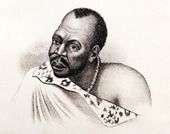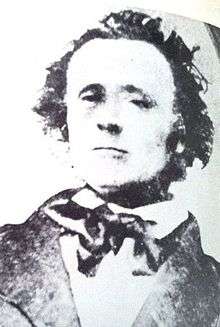Hintsa kaKhawuta
| Hintsa ka Khawuta | |
|---|---|
 Sketch of King Hintsa ka Khawuta from the 1800s | |
| Born | c.1780 |
| Died | 12 February 1835 (aged 54–55) |
Hintsa ka Khawuta (1789 – 12 February 1835), also known as Hintsa the Great or King Hintsa, was the 13th king of the amaXhosa nation from his great ancestor, King Xhosa. He ruled from 1820 until his death in 1835. His territory stretched from Mbhashe River, south of Mthatha to the Gamtoos River in the Southern Cape. Hintsa led the most powerful kingdom (AmaXhosa) in the Eastern Cape, which fought against white colonists for a period of 100 years over the generations.
The Xhosa kingdom is made up of two houses, the Gcaleka House (Great House or the Senior House) which is the ruling house, and the Rharhabe House (Right hand house) which is the second senior house.
Neighbouring kingdoms during Hintsa's time were:
It is very important to note that the AmaMpondo, AbaThembu, AmaBhaca kingdoms are not Xhosa people, they are neighbours to the Xhosa Kingdom. Their kingdoms are autonomous in their own right and should not be confused with being amaXhosa or part of amaXhosa kingdom.
Hintsa was the son of Khawuta ka Gcaleka. His father was in turn the eldest son of Gcaleka ka Phalo. Hintsa had 4 known sons, Sarili ka Hintsa (1810) from his first wife Nomsa kaGambushe Tshezi and Ncaphayi ka Hintsa, Manxiwa ka Hintsa and Lindinyura ka Hintsa from an unknown second wife.
Hintsa's Death

Invited to peace talks by the governor of the Cape, Harry Smith, the British demanded 50 000 cattle in compensation for the 1834 war, and that Hintsa tell all Xhosa chiefs to stop fighting the British. Hintsa was then held captive until the terms were met. Hintsa sent word to Maqoma, his military commander, telling him to hide the cattle.[1][2]
On May 12, 1835 Hintsa, who was about 45, was riding as a prisoner[3] in the company of British soldiers led by Harry Smith. Mostert tells the story[4]
| “ |
Hintsa was being guarded on the ride back over the Kei and the Fish by a corps of guides led by George Southey. Soon after breakfast, Hintsa asked Smith: “What have the cattle done that you want them? Why must I see my subjects deprived of them?” To which Smith replied, “That you know far better than I do.” Soon after that Hintsa spurred his horse forward and galloped away. Smith gave chase and twice tried to fire on the fleeing monarch. Twice his pistols malfunctioned but he caught Hintsa and pushed him off his horse. Hintsa got up and ran, still carrying his assegai. “Shoot, George, and be damned to you,” cried Smith to Southey. Southey fired and hit Hintsa in the leg but still he ran. Southey fired again. Hintsa was again hit but ran into a stream. “Be damned to you,” cried Smith to Southey, “Shoot again.” By this time Hintsa was in deep water and couldn’t stand properly. He threw his spear but it landed harmlessly near Southey, who took aim again. “Mercy,” cried the King. And again. “Mercy.” But there was to be no mercy. Southey, whose Xhosa was fluent, fired, and hit Hintsa in the head, killing him. Southey got to the body first and took off Hintsa’s brass body ornaments for himself. Others grabbed for his beads and bracelets. Southey or his brother William cut off one of Hintsa’s ears as a trophy and someone else cut off the other. A doctor travelling with them was seen trying to pull out some of Hintsa’s teeth. Later, even Smith could no longer bear the barbarity he had caused and ordered Hintsa’s body dropped from his horse and to be left in the bush for his followers to find. Hintsa was captured by the British during the Cape Frontier Wars 1835 and in extenuating circumstances was shot and killed trying to escape resulting in him becoming a martyr for the Xhosa people. His body was subsequently whose body was dismembered by troops in search of grisly momentoes and that his head had been preserved and taken back to Britain." |
” |
His Legacy
He is considered a hero by many Xhosa. These days the Xhosa people know about him through poems and bedtime stories and he is often compared to "Shaka ka Senzangakhona", commonly known as "Shaka Zulu".
In 1996 Nicholas Tilana Gcaleka, a descendant of Hintsa, claimed to have returned the 161-year-old skull of Hintsa from Scotland. He also claimed that he was the great-great nephew of Hintsa and was called on by the spirits of his ancestors to go to Scotland to find Hintsa's head. The Gcaleka Xhosa monarch, King Xolilizwe Sigcau, and his court refused to sanction the planned burial of the skull because they said it was not the disembodied head of Hintsa.
South Africa has institutionalized in 1999 the King Hintsa Bravery Award for leaders that live and act in the spirit of Hintsa kaKhawuta. It was awarded to Jacob Zuma in 2012. Earlier notorious earners of the award include Robert Mugabe from Zimbabwe. The award is being conferred by the ruling Xhosa king.
References
- ↑ MANCOTYWA, SONWABILE (15 May 2010). "Coronation of Xhosa king a time for unity". Times LIVE. Archived from the original on 2012-10-04. Retrieved 2016-03-23.
- ↑ "CAPE OF GOOD HOPE. - CAFFER IRRUPTION.". The Sydney Herald. 16 July 1835. Retrieved 2016-03-23.
- ↑ Cory 1989, p. 102.
- ↑ Mostert 1992.
- Copy of Minutes of Proceedings of the Court of Inquiry held at Fort Willshire ... 1836, ... to investigate and report upon the circumstances attendant on the fate of the Caffer Chief Hintza. MS. note [by Lieut. Col. Hare, President of the Court; together with a copy of the Opinion of the Court]. 1837.
- Mostert, Noël (1992). Frontiers: the epic of South Africa's creation and the tragedy of the Xhosa people. Knopf.
- Cory, George (1989). The Historical "Conversations" of Sir George Cory. Maskew Miller Longman. ISBN 978-0-636-01197-7.